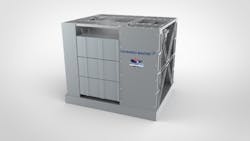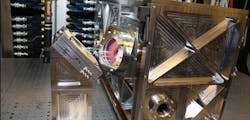Lockheed Martin works to scale high-energy laser weapons to 500 kilowatts
In this Q&A, Lockheed Martin’s Tyler Griffin, business development director of mission systems and weapons, and Eileen Eberley, director of sensors and global sustainment for advanced programs, answer our questions about making high-energy lasers more powerful.
High-energy laser (HEL) weapon systems are a highly desirable solution to counter drones and missiles because they fire a narrow beam of electromagnetic energy, typically within the infrared to visible spectrum, at targets at the speed of light. But a HEL’s reach and damage it can inflict are based on its power, so the U.S. Department of Defense (DoD) wants to increase their power.
Under the second phase of the DoD’s High-Energy Laser Scaling Initiative, Lockheed Martin is working to scale its 300-kilowatt (kW) laser to 500 kW. The goal: Increase laser power while achieving excellent beam quality and optimizing efficiency, size, weight, and volume for these continuous-wave HEL sources.
Laser Focus World: How do advances in laser diodes and fiber optics enable HEL scaling?
Tyler Griffin: The commercial and defense industries often have a synergistic relationship with investments in one paying dividends for the other. This process is cyclic and is one of the main reasons both industries can advance technologies with mutual benefit. In the case of HELs (spectrally beam-combined electric lasers), the significant expansion of the cutting/welding and telecommunications industries in the early 2000s played a pivotal role in helping drive improvements in laser diodes and fiber optics, respectively.
This commercial investment not only led to technical breakthroughs in power and quality, but their widespread availability also drove affordability and reliability. The commercial industrial base continues to expand, which benefits military applications. At Lockheed Martin, we understand maturing advanced technology requires industry collaboration, a sustainable industry base, and a robust supply chain that works at the speed of relevance.
LFW: What can scaling from a 300-kW HEL to a 500-kW HEL enable?
Griffin: Lockheed Martin has more than 40 years’ experience designing, developing, and delivering HELs and laser weapon systems (LWS). We’ve been scaling HELs from our initial 30-kW Accelerated Laser Demonstration Initiative (ALADIN) in 2013 to our recent 300-kW-class laser delivery in 2022 under the DoD’s HELSI. During this time threats continued to evolve, which increases demand for higher power levels for certain missions.
Although it’s just one variable in the LWS lethality equation, moving to 500-kW HELs (see Fig. 1 and video below) enables further standoff ranges and shorter dwell times—resulting in increased lethality.
Laser weapon systems capabilities for air, land, and sea platforms. (Video credit: Lockheed Martin)
LFW: What are the basic laser specs for 500 kW?
Griffin: Our HELs are designed to be rugged and transportable. They’ve been through rigorous testing to military vibration qualification requirements and exhibited excellent performance in tracking, electrical efficiency, beam quality, and the ability to maintain the aimpoint on the target. Our 500-kW-class laser will be tactically configured and ready to support a multitude of military platforms.
LFW: Anything fancy in terms of beam director technology for 500-kW HELs?
Eileen Eberley: From a beam director perspective, we have existing technology in place to integrate our Hammerhead beam director—shaped like the iconic shark’s head to detect and engage threats at any angle—into a 500-kW LWS (see Fig. 2 and video below).
Watch the Hammerhead laser in action. (Video credit: Lockheed Martin)
LFW: Any big challenges getting to 500 kW?
Griffin: With our 2022 delivery of the first tactically relevant electric 300-kW-class laser, Lockheed Martin proved the scalability of our spectral beam combining (SBC) architecture. This architecture’s benefits include a robust design with no moving parts and graceful degradation if one or more fiber lasers experience a fault. We’re excited to have been selected to meet the challenge of again raising the bar of what this architecture can achieve. We look forward to proving the ability to increase the laser’s power level while still achieving excellent beam quality and optimizing efficiency, size, weight, and volume.
Eberley: As far as overcoming challenges, we have the right team in place with our experts in directed energy. There were discussions about increasing the aperture of our beam director as the laser power increases to 500 kW—doing so could have impacts on height, weight, and cost—but there are no technical roadblocks. Our team is up to the challenges that come with reaching 500 kW.
LFW: Any lessons learned from 300-kW HELs being applied to 500-kW HELs?
Griffin: As with all of the HELs we’ve developed and delivered since ALADIN in 2013, we continue to incorporate lessons learned in areas such as designing for producibility and maintainability, accelerating delivery schedule through updated manufacturing processes, and focusing on commonality to increase affordability. We plan to implement these same lessons learned as we execute on the 500-kW HEL program.
Eberley: We’ve benefited greatly from working on the 300-kW system that took us through multiple first-time events, as well as pushing the boundaries of science and technology. Building additional laser systems will allow us the opportunity to improve the speed and reduce the cost of various components and subsystems, which leads to a better performing and more affordable system.
HELs are certainly powerful products to work with, and we were able to glean some important lessons from exercising engineering rigor and discipline throughout the build and test phases. These processes and experiences likewise provided key insights into the assembly and maintenance aspects as well.
LFW: What’s the next scaling goal for HEL power and how far do you envision it going?
Griffin: Looking ahead, Lockheed Martin is scaling from this proven foundation to develop systems that enable higher-power mission capability within incrementally smaller volumes. Consistent with the DoD’s Office of the Under Secretary of Defense (OUSD) for Research & Engineering’s HEL Roadmap, our 500-kW-class HEL contributes to missions that include but aren’t limited to cruise missile and base defense. Strategic missions, which include ballistic and hypersonic missile defense, are likely best addressed as we scale to even higher powers.
These current and future advancements will provide both tactical and strategic advantages that shift the cost calculus for customers. Lockheed Martin looks forward to continuing to partner with the U.S. government to meet their requirements for HEL scaling.
About the Author
Sally Cole Johnson
Editor in Chief
Sally Cole Johnson, Laser Focus World’s editor in chief, is a science and technology journalist who specializes in physics and semiconductors.


